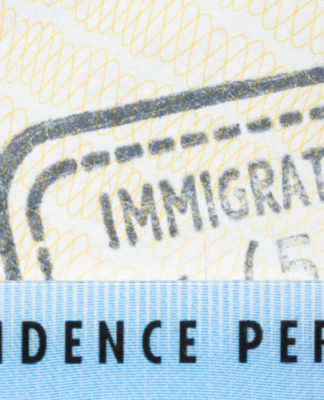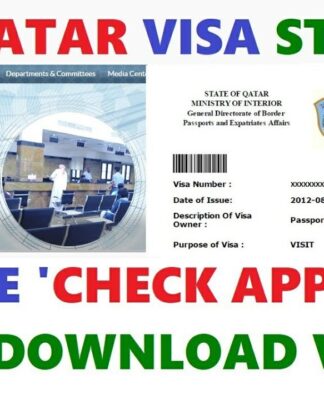A Schengen visa is an official document mandatory for some non-Europeans to travel to all the 26 countries which are part of the Schengen area. Once granted, this visa allows the traveller to cross the borders of the other member-states without going through identity checks at the border. There are several types of Schengen visa but the most common (the short-stay visa) allows to travel/stay for 90 days maximum over a 6 month period starting from the entry date stated on the visa.
Please note
Your entry in a Schengen country can be denied if you are unable to present the copies of the documents required for your Schengen visa application. Therefore it is strongly advised to carry these documents with you during the entire duration of your trip.
TABLE OF CONTENTS :
- What is the Schengen area ?
- Which countries are not part of the Schengen area ?
- Who needs a visa to enter Europe ?
- What are the different kind of Schengen visas ?
- What reasons for visits to Europe require a short-stay Schengen Visa ?
- Where to apply for a Schengen visa ?
- What are the documents required for Schengen visa ?
- How much does a Schengen Visa cost ?
- When should you apply for your visa ?
- What is Schengen insurance ?
- Why choose AXA Schengen Insurance ?
- Does AXA offer other types of Schengen Visa travel insurance ?
- Schengen Visa: Frequently asked questions
What is the Schengen area ?
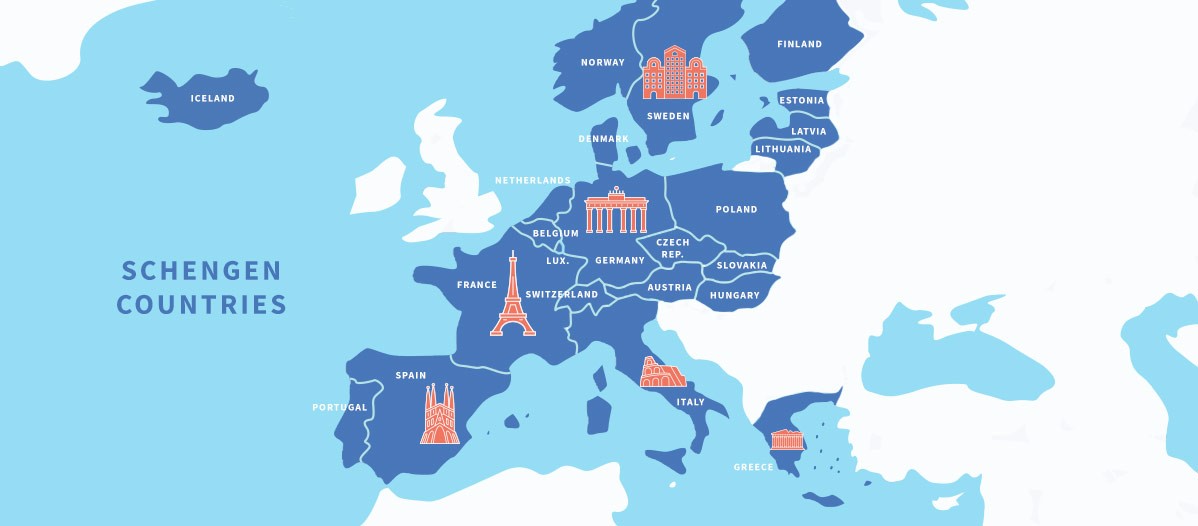
The Schengen Area, or Schengen Countries Zone, is a group of 26 European nations that have abolished border controls between each other. These include France, Germany, Italy, Spain, The Netherlands, Poland, and Scandinavian nations, but not the U.K. and Ireland. Most European Union (EU) countries are signatories to the Schengen Agreement, although some non-Schengen countries, like Bulgaria and Romania, are signed up but not yet active members and merely obliged to join in the future. Switzerland, Iceland, and Norway are not in the EU but are inside of the Schengen Area.
Here is the complete list of 26 countries members of the Schengen zone :
| Austria | Belgium | Czech Republic | Denmark |
| Estonia | Finland | France | Germany |
| Greece | Hungary | Iceland | Italy |
| Latvia | Liechtenstein | Lithuania | Luxembourg |
| Malta | The Netherlands | Norway | Poland |
| Portugal | Slovakia | Slovenia | Spain |
| Sweden | Switzerland |
For more information about Schengen countries.
Which European countries are not part of the Schengen area ?
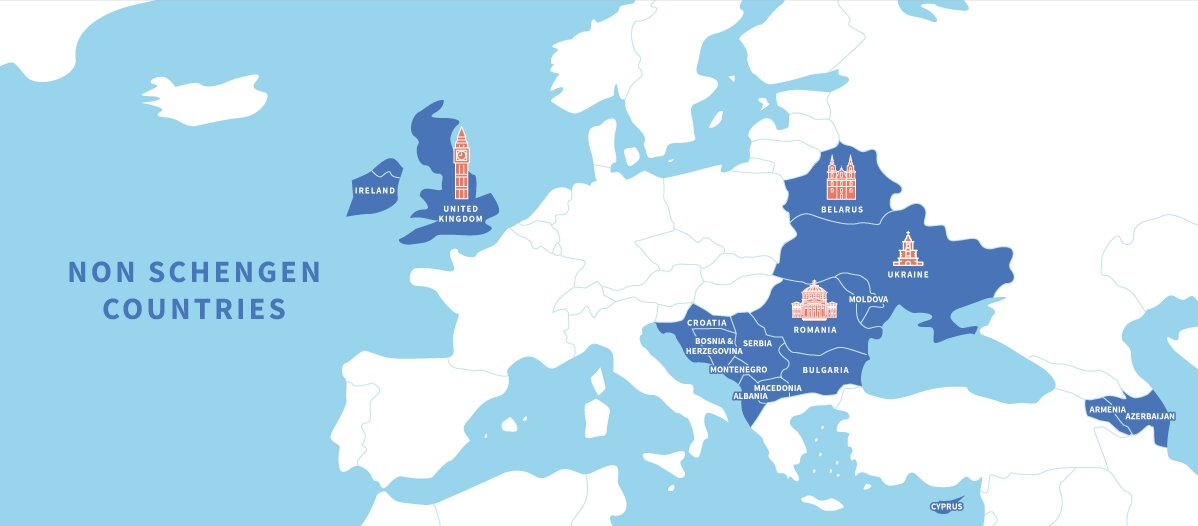
Although 26 countries are inside the Schengen Zone, including most nations in mainland Europe – not every European state is inside the area where border checks have been abolished. Countries we associate with Europe that aren’t in the Schengen Zone :
| Albania | Armenia | Azerbaijan | Belarus |
| Bosnia & Herzegovina | Bulgaria | Croatia | Cyprus |
| Ireland | Macedonia | Moldova | Montenegro |
| Serbia | Ukraine | United Kingdom | Romania |
The microstates of Andorra, Monaco, and Vatican City are also not members – but are considered as de facto inside the area, as they do not impose border controls.
Romania, Bulgaria, Croatia, and Cyprus are also outside of the Schengen Zone but are legally obliged to join as members of the European Union at some point in the future.
Who needs a visa to enter Europe ?
Most non-European citizens (particularly from Africa, Russia, India and China) need a Schengen visa to enter one of the Schengen member states. Some countries, such as the United States, Canada, Mexico, Brazil, Australia and Japan, have signed a visa waiver agreement with the European Union. This means that their nationals don’t need a visa to enter Europe if their visit doesn’t exceed 90 days.
Here is the complete list of countries who need a Schengen visa :
| Afghanistan | Algeria | Angola | Armenia |
| Azerbaidjan | Bahrain | Bangladesh | Belarus |
| Belize | Benin | Bhutan | Bolivia |
| Botswana | Burkina Faso | Burundi | Cambodia |
| Cameroon | Cape Verde | Central African Republic | Chad |
| China | Comoros | Congo | Côte d’Ivoire |
| Cuba | DR of Congo | Djibouti | Dominican Republic |
| Ecuador | Egypt | Equatorial Guinea | Eritrea |
| Ethiopia | Fiji | Gabon | Gambia |
| Ghana | Guinea | Guinea-Bissau | Guyana |
| Haiti | India | Indonesia | Iran |
| Iraq | Jamaica | Jordan | Kazakhstan |
| Kenya | Kosovo | Kuwait | Kyrgyzstan |
| Laos | Lebanon | Lesotho | Liberia |
| Libya | Madagascar | Malawi | Maldives |
| Mali | Mauritania | Mongolia | Morocco |
| Mosambique | Namibia | Nepal | Nigeria |
| North Corea | Northern Marianas | Oman | Pakistan |
| Papua New Guinea | Philippines | Qatar | Russia |
| Rwanda | São Tomé and Principe | Saudi Arabia | Senegal |
| Sierra Leone | Somalia | South Africa | Sri Lanka |
| Sudan | Suriname | Swaziland | Syria |
| Tajikistan | Tanzania | Thailand | Timor-Leste |
| Togo | Tonga | Tunisia | Turkey |
| Turkmenistan | Uganda | Uzbekistan | Vietnam |
| Yemen | Zambia | Zimbabwe |
However residents, and not yet citizens, of such countries will need a Schengen visa if they are originally from countries which haven’t signed this waiver agreement.
For more information, please read the following page : Do I need a Schengen visa ?
What are the different kind of Schengen visas ?
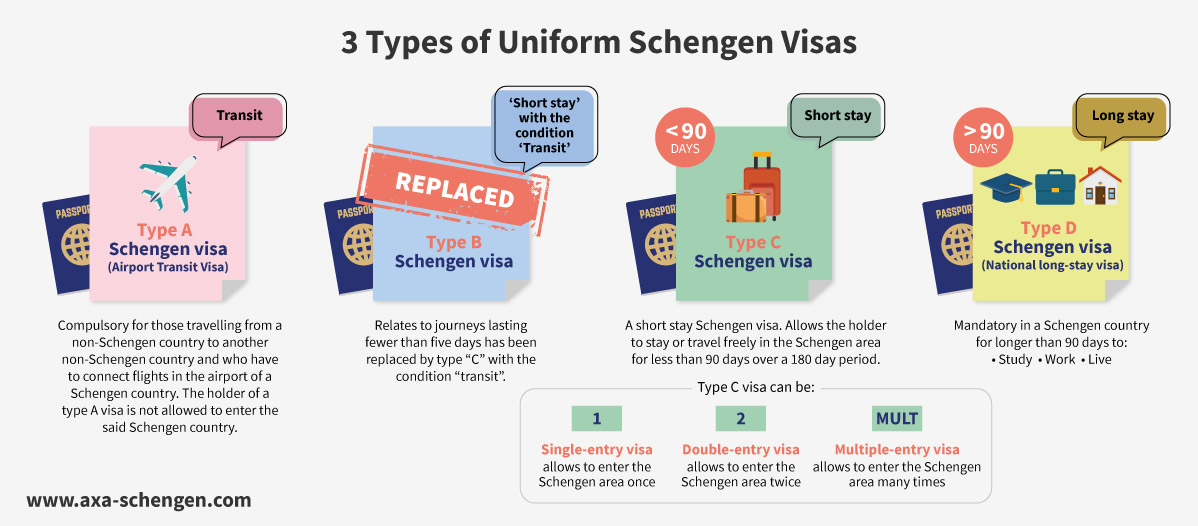
- Type A Schengen visa – Airport Transit Visa
The type A visa (Airport Transit Visa) allows citizens of non-Schengen states to transit through or wait for their connecting flight in the international zone of an airport located in a Schengen country. It is compulsory for those travelling from a non-Schengen country to another non-Schengen country and who have to connect flights in the airport of a Schengen country. The holder of a type A visa is not allowed to enter the said Schengen country.
- Type B Schengen visa
The type B visa relates to journeys lasting fewer than five days has been replaced by type “C” with the condition “transit”.
- Type C Schengen visa
The short stay Schengen visa is the most common one. It is issued by the visa services (embassies, consulates, appointed external providers) of a country belonging to the Schengen area. It allows the holder to stay or travel freely in the Schengen area for less than 90 days over a 180 day period.
According to the purpose of your trip, the short-stay category C Schengen visa can be : a single-entry, a double-entry or a multiple-entry.
- Type D Schengen visa
The national visa is the type D long-stay Schengen visa. It is mandatory for any foreigner wishing to study, work or live in a Schengen country for longer than 90 days (up to 1 year).
For more information, please read the following page : What kind of Schengen visa do I need ?
What reasons for visits to Europe require a short-stay Schengen Visa ?
You need to apply for a Schengen Visa if you intend to visit one or more European countries in the area for any of the following reasons: Tourism and recreation, business purposes, visiting friends or family, cultural and sporting events, airport and seafaring transit visits, official visits, medical treatment, short-term study, and research purposes.
Depending on your reasons for visiting the Schengen Area countries and the frequency of your visits, the Schengen consulate can issue you a single, double, or a multiple-entry visa – valid for 90 days. However, if you are a frequent traveler, you may apply to obtain a multiple-entry Schengen Visa valid for up to five years. On each visit, you will only be able to stay within the Schengen Area for up to 90 days in a 180-day period.
Where to apply for a Schengen visa ?
To apply for a Schengen visa you will need to contact the consular authorities of the Schengen country you wish to visit.
If the country you plan to visit does not have an embassy or consulate, you will have to address your application file to the local representatives of this country.
Visa applications are sometimes processed by external service providers (such as VFS Global or TLS) which are authorized to receive application files.
Please note. You need to apply at the embassy of the country you’re staying in for the longest amount of time. Or if you are staying for the same amount of time in two Schengen Area states, the one you are visiting first. If your travel plans are flexible, countries like Lithuania and Estonia grant the most visa applications and often process them faster due to receiving fewer visa requests.
Visit this page for more information : Embassies & consulates for Schengen visa
What are the documents required for Schengen visa ?
The Schengen Visa application process can be confusing and stressful if you do not know what you are doing, so we have prepared a handy guide to take you through each of the 37 steps you need to follow to apply for a Schengen Visa :
To book an appointment with the competent authorities, you must first put together an application file with the following mandatory documents :
• A duly completed and signed visa application form
• Two identical and recent id photos
• A copy of your passport and your passport (issued less than 10 years ago and valid for at least 3 months beyond the expiration date of the requested visa)
• A letter explaining the reasons of your trip
• The reservation confirmation of your return ticket
• Proof of your accommodation plans
• Proof of your means of subsistence
• A mandatory travel insurance certificate
With a complete application file you will be able to attend your appointment with the consular services in the best conditions.
For more information, please consult our page on documents required for a schengen visa application (you can also download a visa application on that page).
How much does a Schengen Visa cost?
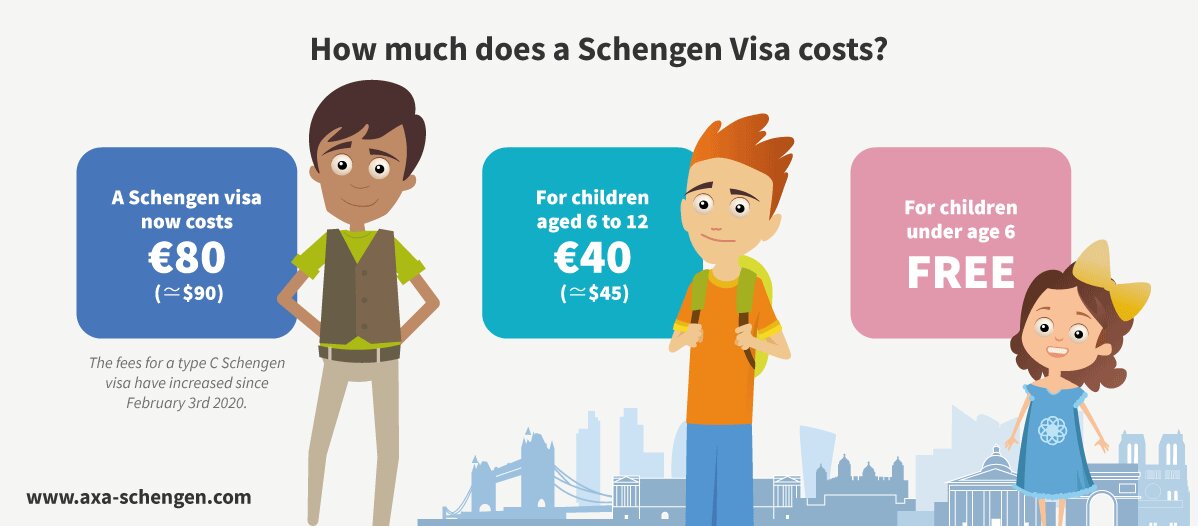
The fees for a type C Schengen visa have increased since February 3rd 2020 :
- A Schengen visa now costs €80 (≃$90).
- For children aged 6 to 12: €40 (≃$45).
- For children under age 6: free
When should you apply for your visa ?
Since the implementation of the new Visa Code (February 2020) you can now apply for your Schengen visa at the earliest 3 to 6 months prior to the date of your trip and at the latest 15 calendar days before your departure date.
In average W.
What is Schengen insurance ?
To obtain your Schengen Visa, your travel and medical insurance must meet several minimum requirements. It must cover you in the whole Schengen Area – even countries you have no plans to visit – and cover accidents, illnesses, and emergency treatments, as well as repatriation in case of death, for a minimum of €30,000 (≃$35,000).
Why choose AXA Schengen Insurance ?
AXA offers several Schengen Visa compliant insurance policies for travel in Europe; from a low-cost option, priced at as little as €0.99 ($1.11) per day of your trip, that will meet the minimum requirements, to multi-trip insurance that will cover you for ongoing visits.
AXA travel insurance policies are accepted in all embassies and consulates of Schengen Area countries.
After buying your travel insurance, you will receive a certificate that can be presented to officials at the consulate or visa application center, to show you have the correct insurance for your Schengen Visa.
Does AXA offer other types of Schengen Visa travel insurance ?
AXA also offers more comprehensive Europe Travel insurance from €1.50 per day of your trip, that covers you for medical expenses up to €100,000. If you’re planning more than one trip, you may want to buy the year-round coverage for €298 – this will cover you for all your visits to Schengen Area countries within the year.
















